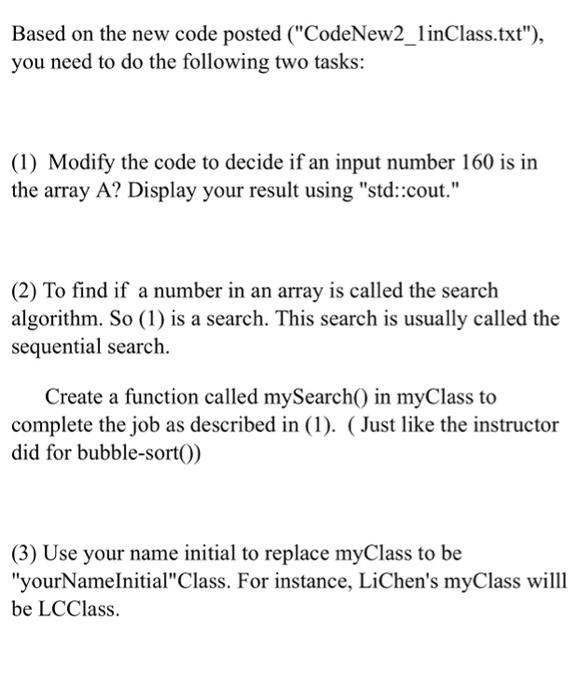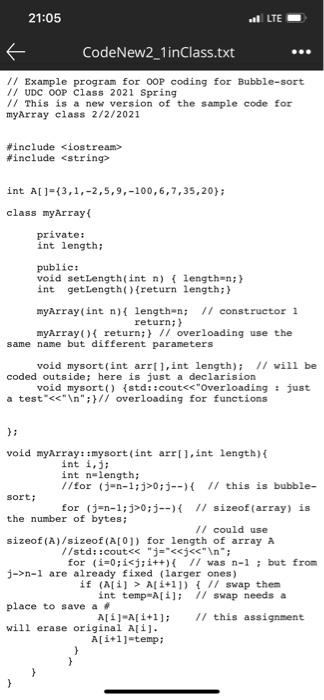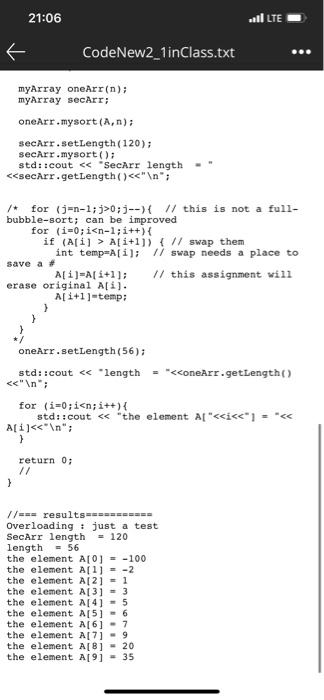ASAP please

Based on the new code posted ("CodeNew2_linClass.txt"), you need to do the following two tasks: (1) Modify the code to decide if an input number 160 is in the array A? Display your result using "std::cout." (2) To find if a number in an array is called the search algorithm. So (1) is a search. This search is usually called the sequential search. Create a function called mySearch() in myClass to complete the job as described in (1). (Just like the instructor did for bubble-sort() (3) Use your name initial to replace myClass to be "yourNameInitial"Class. For instance, LiChen's myClass willl be LCClass. 21:05 LTE CodeNew2_1inClass.txt // Example program for oop coding for Bubble-sort 1/ UDC OOP Class 2021 Spring // This is a new version of the sample code for myArray class 2/2/2021 #include
#include int A[]={3,1,-2,5,9,-100,6,7,35,20); class myArray private: int length; public: void setLength(int n) { length=n; } int getLength() {return length; } myArray(int n){ length-n; // constructor 1 return; ) myArray(){ return;} // overloading use the same name but different parameters void mysort(int arrt], int length); // will be coded outside; here is just a declarision void mysort() {std::cout0;-){ // this is bubble- sort; for(j=n-1;j>0;j--){ Il sizeof(array) is the number of bytes; // could use sizeof(A)/sizeof(A[0]) for length of array A //std::coutn-1 are already fixed (larger ones) if (A[i] > A[i+1]) { // swap them int temp=A[i]; // swap needs a place to save a A[1]A[i+1]; // this assignment will erase original Ali). A[i+1]-temp; } 21:06 ll LTE CodeNew2_1inclass.txt // Alg of Bubble-sort // Step (1): Let i=0, go through the array by comparing its right-neighbor 17 swap them (A[i], A[i+1]) if (A[i]> A[i+1]). will get the biggeset # on the right (last element). 1/ Step (2): i go back to 0; start over Step 1, we will get the second largest #. // repeat agian and again, until no one left in the array that is not sorted. // How many for-loops do we need? 2 // int main() { int i; int n-10; myArray oneArr(n); myArray secArr; oneArr.mysort(A,n): secArr.setLength(120); secArr.mysort(); std::cout 0;1--){ // this is not a full- bubble-sort; can be improved for (i=0;i A[i+1]) { // swap them int temp=A[i]; // swap needs a place to save a # A[i]A[i+1]: // this assignment will erase original A[i]. A[i+1]-temp; } oneArr.setLength (56); std::cout 0;1--){ // this is not a full- bubble-sort; can be improved for (i=0;i A[i+1]) { // swap them int temp=A[i]: 1/ swap needs a place to save a + A[1]=A[i+1]; // this assignment will erase original A[i]. A 1+1]-temp: } oneArr.setLength(56); std::cout #include int A[]={3,1,-2,5,9,-100,6,7,35,20); class myArray private: int length; public: void setLength(int n) { length=n; } int getLength() {return length; } myArray(int n){ length-n; // constructor 1 return; ) myArray(){ return;} // overloading use the same name but different parameters void mysort(int arrt], int length); // will be coded outside; here is just a declarision void mysort() {std::cout0;-){ // this is bubble- sort; for(j=n-1;j>0;j--){ Il sizeof(array) is the number of bytes; // could use sizeof(A)/sizeof(A[0]) for length of array A //std::coutn-1 are already fixed (larger ones) if (A[i] > A[i+1]) { // swap them int temp=A[i]; // swap needs a place to save a A[1]A[i+1]; // this assignment will erase original Ali). A[i+1]-temp; } 21:06 ll LTE CodeNew2_1inclass.txt // Alg of Bubble-sort // Step (1): Let i=0, go through the array by comparing its right-neighbor 17 swap them (A[i], A[i+1]) if (A[i]> A[i+1]). will get the biggeset # on the right (last element). 1/ Step (2): i go back to 0; start over Step 1, we will get the second largest #. // repeat agian and again, until no one left in the array that is not sorted. // How many for-loops do we need? 2 // int main() { int i; int n-10; myArray oneArr(n); myArray secArr; oneArr.mysort(A,n): secArr.setLength(120); secArr.mysort(); std::cout 0;1--){ // this is not a full- bubble-sort; can be improved for (i=0;i A[i+1]) { // swap them int temp=A[i]; // swap needs a place to save a # A[i]A[i+1]: // this assignment will erase original A[i]. A[i+1]-temp; } oneArr.setLength (56); std::cout 0;1--){ // this is not a full- bubble-sort; can be improved for (i=0;i A[i+1]) { // swap them int temp=A[i]: 1/ swap needs a place to save a + A[1]=A[i+1]; // this assignment will erase original A[i]. A 1+1]-temp: } oneArr.setLength(56); std::cout <-1><-1><-1><-1>











